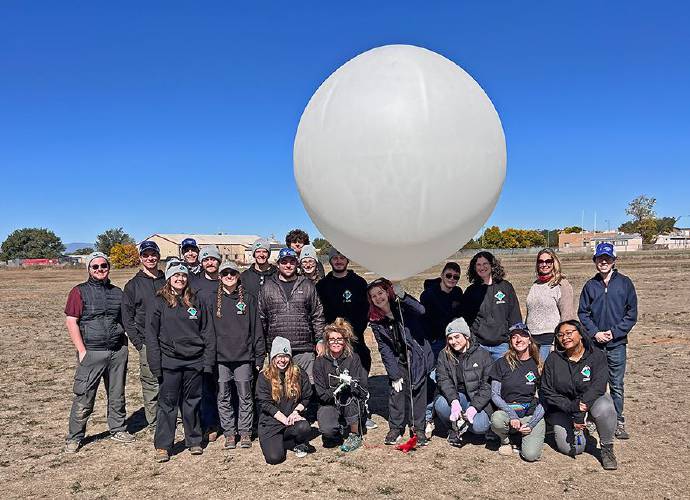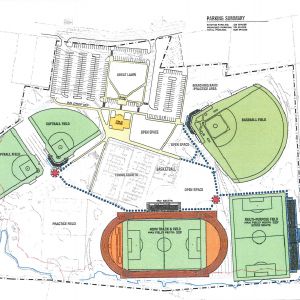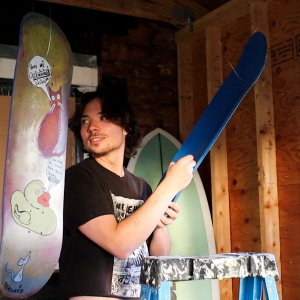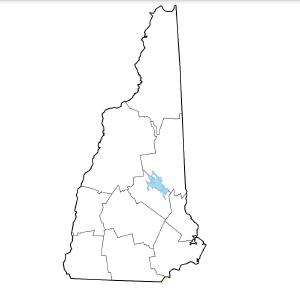Granite Geek: Studying results of the eclipse with balloons and ham radios

The Plymouth State University team in New Mexico during 2023 launches of weather-monitoring balloons during a solar eclipse. They will be performing similar research in the town of Pittsburg, N.H., around the April 8 solar eclipse. Emily Roy, Plymouth State University – Courtesy
| Published: 04-01-2024 5:10 PM |
Next Monday I will be lazing around while watching the solar eclipse up near the Canadian border, having received assurances that there will be no clouds whatsoever, but some folks around New Hampshire will be approaching the event more seriously as part of two national distributed-science projects.
In northern Coos County, students from Plymouth State University will be spending 30 hours releasing human-sized weather balloons, one per hour, to collect data on temperature, humidity, air pressure, winds and ultraviolet rays between the ground and about 100,000 feet. They’re one of 55 teams around the country doing this in a project coordinated by NASA.
“We’re going to look at the impacts of the eclipse in the boundary layer, which is about the lowest two kilometers of the atmosphere just above the surface,” said Genevieve Picciano, a masters student at PSU. “They send data back to the ground station, go up 32,000 meters, then pop, everything falls back to the ground.”
This won’t be the team’s first such effort. They were part of a similar distributed research project in October 2023, when they went to the New Mexico desert to launch balloons during a solar eclipse.
Next week’s project “will produce an absolutely massive dataset, from about 570 profiles. It’s the largest dataset of radiosonde data likely ever collected,” Picciano said. (Radiosonde sounds like it’s the brand of a Central European broadcast company, but is actually the term for a battery-powered telemetry instrument carried into the atmosphere for data collection.)
Picciano’s research will incorporate all this data into models that predict atmospheric response to solar eclipses, when we go from full heat and sun to darkness and back again in a couple of hours instead of overnight. “It’s pretty easy to tell how the solar radiation changes during an eclipse, but it’s more difficult for the model to forecast how the atmosphere is going to respond,” she said.
PSU has long been known for its meteorology programs and recently created a bachelor’s degree in climate studies, so this project fits the school well. A total of 17 students, from sophomores to grad students in several disciplines, and three faculty will be participating. That includes art students who will be making media that will be displayed at PSU’s Museum of the White Mountains.
Another project triggered by the eclipse involves amateur radio operators throughout the country who will be using their signals to study the effect of the moon’s shadow on the ionosphere, the charged portion of the atmosphere.
Article continues after...
Yesterday's Most Read Articles
 By all appearances, Canadians are leery of coming to NH
By all appearances, Canadians are leery of coming to NH
 Plans advance on $27M Memorial Field project
Plans advance on $27M Memorial Field project
 “A dream come true” – Family opens housing for adults with disabilities in Concord
“A dream come true” – Family opens housing for adults with disabilities in Concord
 Memorial Day events in the Concord area
Memorial Day events in the Concord area
 Giving life back to board sports: Back Alley Boards upcycles boards into art
Giving life back to board sports: Back Alley Boards upcycles boards into art
 ‘I thought we had some more time’ – Coping with the murder-suicide of a young Pembroke mother and son
‘I thought we had some more time’ – Coping with the murder-suicide of a young Pembroke mother and son
David McGaw, a research engineer at Dartmouth College Department of Physics and Astronomy who is part of the NASA-funded project, explained it to me.
Amateur radio, like AM and FM radio, can bounce signals off the ionosphere, letting them go far beyond line-of-sight transmission. That’s how ham radios can connect with stations on the other side of the planet.
But different frequencies behave differently depending on how ionized, or charged, the atmosphere is. That changes during the day because UV light from sunlight causes the lowest level to be highly charged so that it absorbs rather than reflects short and medium radio waves. When the sun goes down the absorption stops, meaning most frequencies can take advantage of the ionosphere’s reflection effect.
This effect is best known from AM radio stations. During the day their signal doesn’t go terribly far but at night they can do the ionization bounce and travel hundreds of miles or more. You won’t pick up a station from Chicago when it’s sunny but you might at midnight.
Hundreds of amateur radio operators known as the HamSCI Network will be sending radio signals out during the eclipse to monitor the effects as the moon’s shadow causes the ionosphere to decharge (is that a word?) and then recharge in a short period.
They won’t know how many people in New Hampshire or elsewhere are participating until the logs are filed but I suspect it’ll be a few. “We have a very large contingent in New England,” McGaw said.
A related event will involve monitoring WWV, the Colorado station that transmits a time signal at several different frequencies, to see how they change as the eclipse passes by.
Data from the HamSCI project, led by Prof. Nathaniel Frissell at the University of Scranton, is useful because the ionosphere can affect crucial communication and navigation equipment.
McGaw said he has another interest. He’s part of Dartmouth’s plasma physics group which, among other things, studies solar wind and how it interacts with the ionosphere. While it doesn’t seem likely to me that these ham radio people will find anything that isn’t already known from decades of satellite and ground-based observation, you never know until you try.
Which, come to think of it, is a pretty good description of science.
Enjoy next week’s eclipse – as long as you have good-enough glasses.







 ‘The smiles say it all’: Sweet Dreamz brings creative soft-serve to Penacook
‘The smiles say it all’: Sweet Dreamz brings creative soft-serve to Penacook  Drought is completely gone from New Hampshire – maybe it can stop raining now?
Drought is completely gone from New Hampshire – maybe it can stop raining now?
